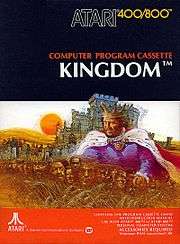Atari 8-bit computer software

This article covers various significant pieces of software available for the Atari 8-bit home computers (400/800, XL and XE series). Because the company marketed them as home computers, games dominated the 8-bit software library.
For coverage of the operating system, please refer to the section within the main article.
Available programming languages
- Action! – A product of Optimized Systems Software. A high performance language that compiled to machine code, with good support for Atari's hardware. While it was popular with hobbyists, it never attained widespread acceptance, particularly since it was limited to the Atari 8-bit platform.
- Assembly language
- Atari Assembler Editor – A 6502 assembler editor and compiler was released by Atari in a ROM cartridge.
- Atari Macro Assembler (AMAC) – A macro assembler released by Atari Program Exchange (APX) in disk form. Copy protected.
- MAC/65 – 6502 macro assembler/editor developed by Optimized Systems Software. Released in disk and cartridge forms.
- Synassembler – Assembler from Synapse Software. Written by Steve Hales. Not compatible with XL/XE computers without patching.
- Macro Assembler/Text Editor (MAE) – Assembler from Eastern House Software by Carl Moser.
- ATMAS II
- BASIC dialects.
- Atari BASIC – This was the original BASIC for the Atari 8-bit family. Came as a ROM cartridge with the Atari 400/800 models, but was built into the computer's ROM in later models. In the XL/XE models, BASIC could be disabled by holding down the OPTION key while booting.
- Atari Microsoft BASIC – A version of BASIC for the Atari 8-bit family released by Atari that was more compatible with Microsoft BASIC. It was initially released on disk only. Microsoft BASIC II was the same except it was in a ROM cartridge plus extension disk.
- Turbo Basic XL – An improved version of Atari BASIC released by a third party that is not only faster, but offers many more commands. There is also a compiler that makes Turbo-BASIC XL programs even faster by compiling them into machine-language binaries.
- BASIC A Plus — An extended BASIC from Optimized Systems Software
- BASIC XL — An improved BASIC from Optimized Systems Software
- BASIC XE — An enhanced version of BASIC XL from Optimized Systems Software
- Advan BASIC – This BASIC was written by William Graziano (Advan Language Designs) which was a full featured BASIC with advanced sound and player-missile support. There is also a BASIC compiler, Screen Design, and Utility package. This software was released to public domain in 2006 by William Graziano
- C (Programming Language)
- Deep Blue C – A C compiler. Written by John Palevich, APX. Based on Ron Cain's popular Small-C compiler.
- LISP
- INTER-LISP/65
- LOGO
- PILOT
- Atari PILOT
- Pascal
- Atari Pascal – Required two drives.
- Draper Pascal
- Kyan Pascal
- Forth
- Antic Forth
- ES-Forth
- fig Forth
- gForth
- mforth
- QS-Forth
- ValForth
- VolksForth
- X-Forth
After Atari's 8-bit machines entered the realm of retrocomputing in the late 1990s, cross platform development tools such as XASM, TASM, and cc65, most commonly run on PCs, have been much used by enthusiasts to do programming intended for the machines.
Applications
- See Category:Atari 8-bit family software.
Games
- See Category:Atari 8-bit family games.
Because of graphics superior to that of the Apple II[1] and Atari's home-oriented marketing,[2] the computers gained a good reputation for games. Jerry Pournelle wrote in 1982, when trying to decide what computer to buy his sons, that "if you're only interested in games, that's the machine to get. It's not all that expensive, either".[1] Games dominated the Atari software library and there were fewer business applications than for the Apple II. A 1984 compendium of reviews used 198 pages for games compared to 167 for all others. It noted the existence of a distinct "graphics look" to native Atari software: "Multiple graphics modes, four directional fine scrolling, colorful modified character-set backgrounds, and, of course, player missile graphics."[2]
Star Raiders was Atari's killer app, akin to VisiCalc for the Apple II in its ability to persuade customers to buy the computer.[3] Antic in 1986 stated that "it was the first program that showed all of the Atari computer's audio and visual capabilities. It was just a game, yes, but it revolutionized the idea of what a personal computer could be made to do."[4]
References
- 1 2 Pournelle, Jerry (July 1982). "Computers for Humanity". BYTE. p. 392. Retrieved 19 October 2013.
- 1 2 Stanton, Jeffrey; Wells, Robert P.; Rochowansky, Sandra; Mellid, Michael, eds. (1984). The Addison-Wesley Book of Atari Software. Addison-Wesley. pp. TOC,12,210. ISBN 0-201-16454-X.
- ↑ Williams, Gregg (May 1981). "Star Raiders". BYTE. p. 106. Retrieved 18 October 2013.
- ↑ Bisson, Gigi (May 1986). "Antic Then & Now". Antic. 5 (1). pp. 16–23. Retrieved 28 January 2015.